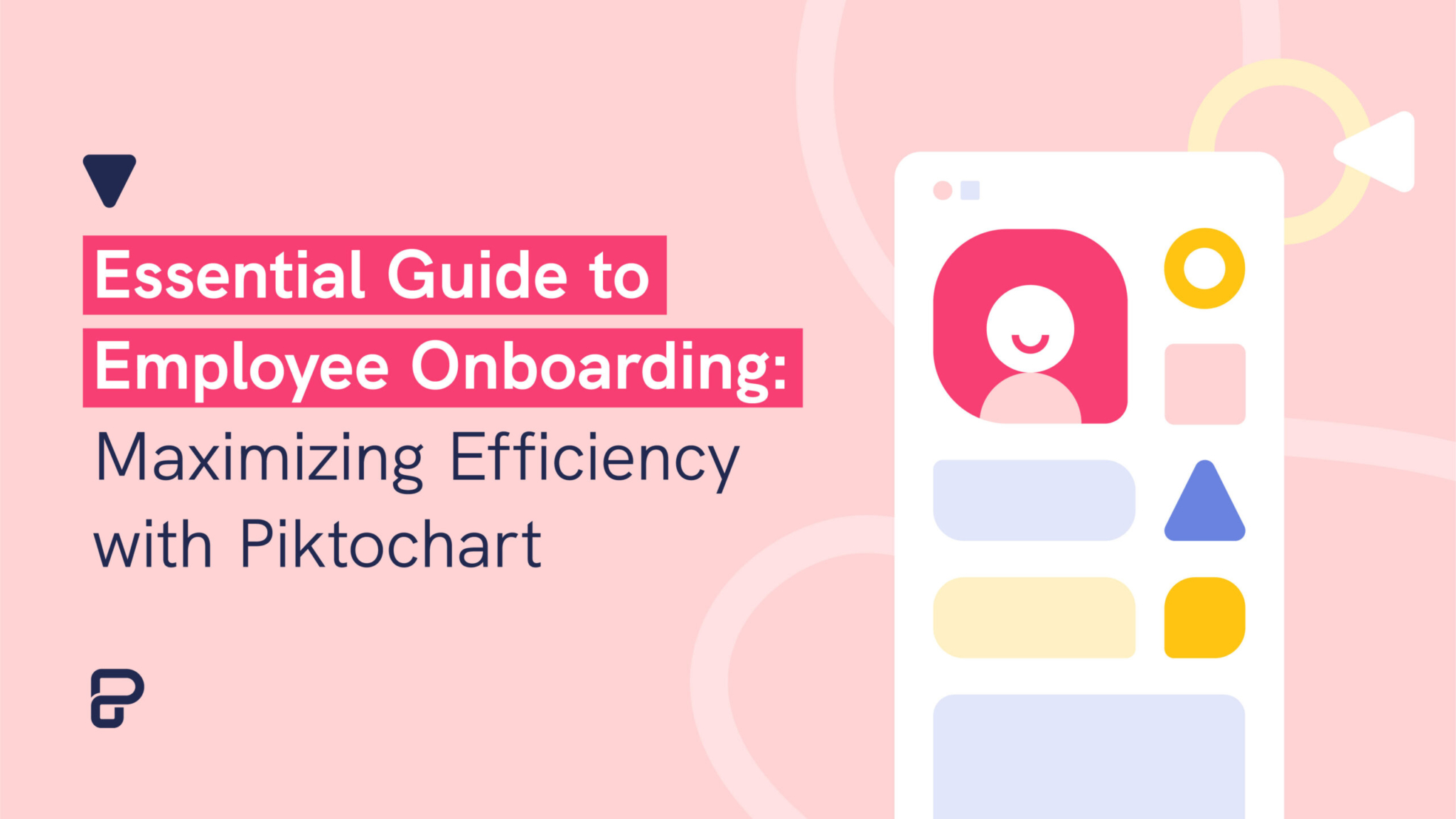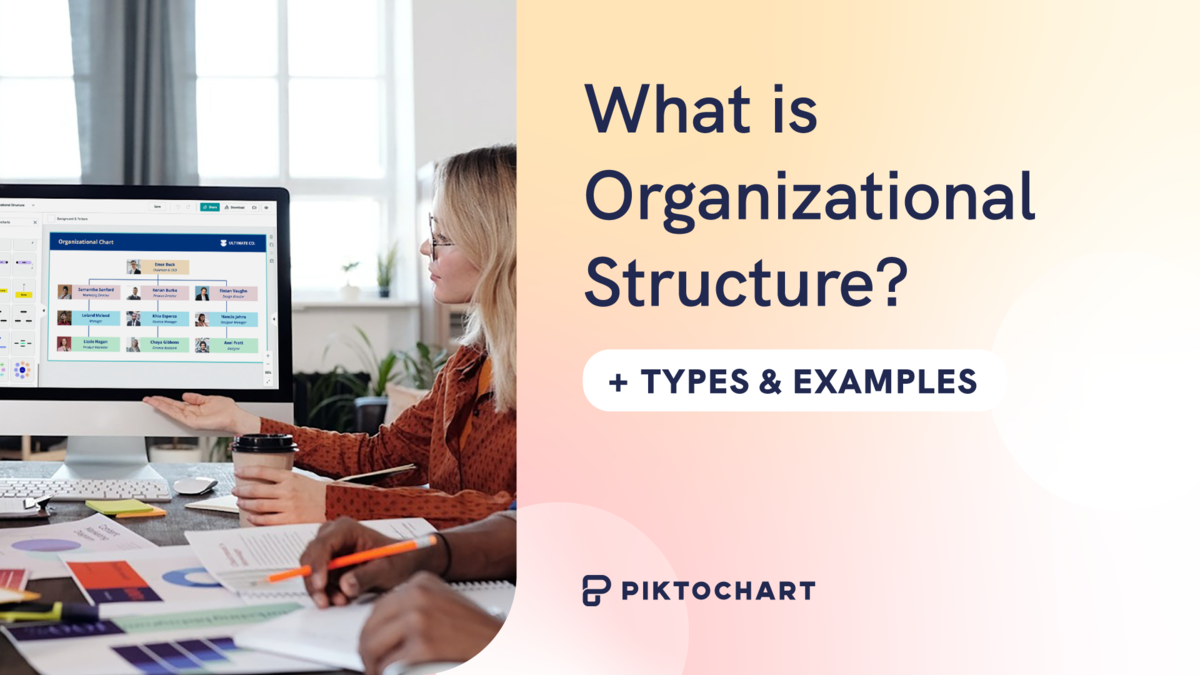Once upon a time in the heart of Penang, Malaysia, a tech startup named Piktochart was undergoing a dramatic period of growth. Their product, a visual communication tool, had taken the market by storm and they were rapidly adding new members to their team to keep up with demand.
But with each new hire, they realized a glaring problem: their lack of a structured onboarding program was leading to confusion, miscommunication, and wasted time. Employees were thrown into the deep end without a clear understanding of their roles, or the company’s processes.
Seeing this, Shen Dee, the former Head of HR, took it upon herself to create an effective onboarding program. She recognized the immense value that a well-executed onboarding process could bring not just to the new employees, but to the entire organization. She set out to create an onboarding experience that would be both welcoming and informative, ensuring that each new team member would feel equipped, engaged, and ready to contribute to Piktochart’s mission from day one.
Similar to Shen Dee, as an HR professional, your top priority is to make sure that the employee onboarding process is as smooth and efficient as possible.
This article will provide a foundation for you to get started with your employee onboarding program.
You can also follow along by selecting one of our employee onboarding templates for free. Simply create a free account to access the template gallery.
Table of contents
Why is it important to have a good employee onboarding program in place?
Onboarding is a crucial part of any business! And here’s the thing: it’s not just good for new hires, it’s great for the company too!
Why, you ask?
Well, for starters onboarding is great for faster integration. It helps get new hires up to speed with their roles, enables them to join teams quickly, and helps them get acclimated to the company. By rapidly understanding the role, expectations and performance standards, output and success are enhanced.
Onboarding also improves employee retention rates, and it helps establish company culture by ensuring that employees are aligned with the company’s mission, culture, and values. 🌟 Effective onboarding instills a sense of belonging, fostering commitment and active involvement!
By investing in onboarding, staff turnover decreases, efficiency improves and costs saved!
What metrics track the effectiveness of a new employee onboarding program?
Evaluating the effectiveness of an employee onboarding program is crucial to improving it over time. Here are some key metrics that can help measure its success:
Time to Productivity
This is the period it takes for a new hire to reach the expected level of productivity. A shorter time to productivity generally indicates a successful onboarding process.
Retention Rate
This measures the percentage of new hires who remain with the company after a certain period, typically a year. If the retention rate is high, this suggests that the onboarding program is effective. According to a study by Brandon Hall Group, organizations with a standard onboarding process have seen an improvement in new hire retention by 82%.
New Hire Performance
Evaluating new hires’ performance can help assess the effectiveness of your onboarding program. This could be measured against key performance indicators (KPIs) specific to their roles. A report from Glassdoor suggests that a strong onboarding process can improve new hire productivity by over 70%.
New Hire Satisfaction
Employee feedback is a critical measure of onboarding success. Survey new hires to gather their feedback on the onboarding experience and their level of job satisfaction. A 2007 study from the Wynhurst Group has found that employees who undergo structured onboarding are 58% more likely to stick with the company for three years or more.
Time to First Promotion
This measures the time it takes for new hires to advance in the organization.
Engagement Level
Engaged employees are more likely to be productive and remain with the company. Employee engagement can be measured through surveys and direct feedback.
90-Day Failure Rate
If a significant number of new hires leave or are let go within the first 90 days, it could be an indication that something is amiss in the onboarding process. As per a study by Leadership IQ, about 46% of rookies wash out in their first 18 months.
Quality of Work
Evaluate the work product of new employees. Are they meeting the expected standards? Is there a need for frequent corrections?
Onboarding Cost
Calculate the total cost of onboarding new employees, and assess whether the return on investment makes sense in terms of their productivity and contribution to the company.
Measuring metrics is just half the battle. It’s what you do with them that really counts. With the right data in your hands, you can take action and continuously improve your onboarding process. 🚀
A comprehensive employee onboarding process
An effective onboarding process usually spans a period of 90 days or more and can be broken down into various stages, including before they join, the first 30 days, 60 days, and 90 days. We’ve provided a helpful employee onboarding checklist for you here:
Before They Join: Pre-boarding
- Offer letter and paperwork: Ensure the offer letter and other necessary new hire paperwork are signed and returned promptly.
- Introduction email: Send an introductory email to the new hire detailing what they can expect on their first day.
- Provide necessary information: Share details about company literature, policies, work timings, dress code, and anything that they should know before starting.
- Set up technology: Ensure the new hire’s workspace, email, software, and hardware requirements are set up.
- Announcement: Let the team or company know about the new hire.
First 30 Days: Orientation and Integration
- First Day Orientation: Welcome the new employee, conduct a tour of the office, and introduce them to their team members. Let them know how long should onboarding be.
- Role clarity: Clearly define their job responsibilities, goals, and how their role contributes to the organization’s overall objectives.
- Training: Begin the necessary job-specific training and provide information about any training programs available.
- Assign a mentor or buddy: A designated colleague can help them understand the workplace culture and processes, and answer any questions.
- Frequent Check-ins: Regularly check in to ensure they feel comfortable and to answer any questions they may have.
60 Days: Training and Development
- Ongoing Training: Continue with any necessary job-specific training, and start expanding on it.
- Performance Expectations: Ensure that the employee fully understands their performance goals and how they will be evaluated.
- Provide Feedback: Offer constructive feedback on their work and progress so far.
- Encourage Networking: Encourage the new hire to interact with colleagues from other departments to gain a broader understanding of the company.
- Check-in Meeting: Hold a formal 60-day check-in meeting to discuss their experiences, address any concerns, and help them set future objectives.
90 Days: Evaluation and Feedback
- Performance Review: Conduct a formal 90-day performance review to assess their work, provide feedback, and discuss their future goals.
- Feedback from the Employee: Ask for their feedback on the onboarding process. What worked well? What could be improved?
- Future Planning: Help them plan their future path within the company. Discuss their career goals and provide resources to help them achieve these goals.
- Recognition: Acknowledge the new hire’s achievements during the first 90 days to motivate and encourage them.

And it doesn’t stop there! It’s important to keep checking in within the first year.
Pre-Onboarding:
- Prepare Offer Letter and Paperwork: Ensure that all necessary paperwork, including contracts, tax forms, and any other legal documentation, are prepared and sent.
- Technology Setup: Set up their email, provide necessary hardware (computer, phone etc.), and ensure they have access to necessary software and systems.
- Schedule First Day: Set an agenda for their first day that includes a company tour, team introductions, and initial training.
- Notify the Team: Inform the team about the new hire’s start date and role.
- Prepare Workspace: Arrange a workspace with all the necessary supplies.
First Day:
- Welcome Meeting: Give a warm welcome and a tour of the office/facilities.
- Introductions: Introduce the new hire to their team and other key members of the company.
- Review Agenda: Outline what the new employee can expect in the first few weeks.
- First Day Training: Start with basic training on job role, responsibilities, and company policies.
First Week:
- Company Policies: Provide training on company policies, including compliance issues, health and safety, and data security.
- Job-Specific Training: Begin more intensive, role-specific training.
- Meetings: Arrange meetings with key team members and managers.
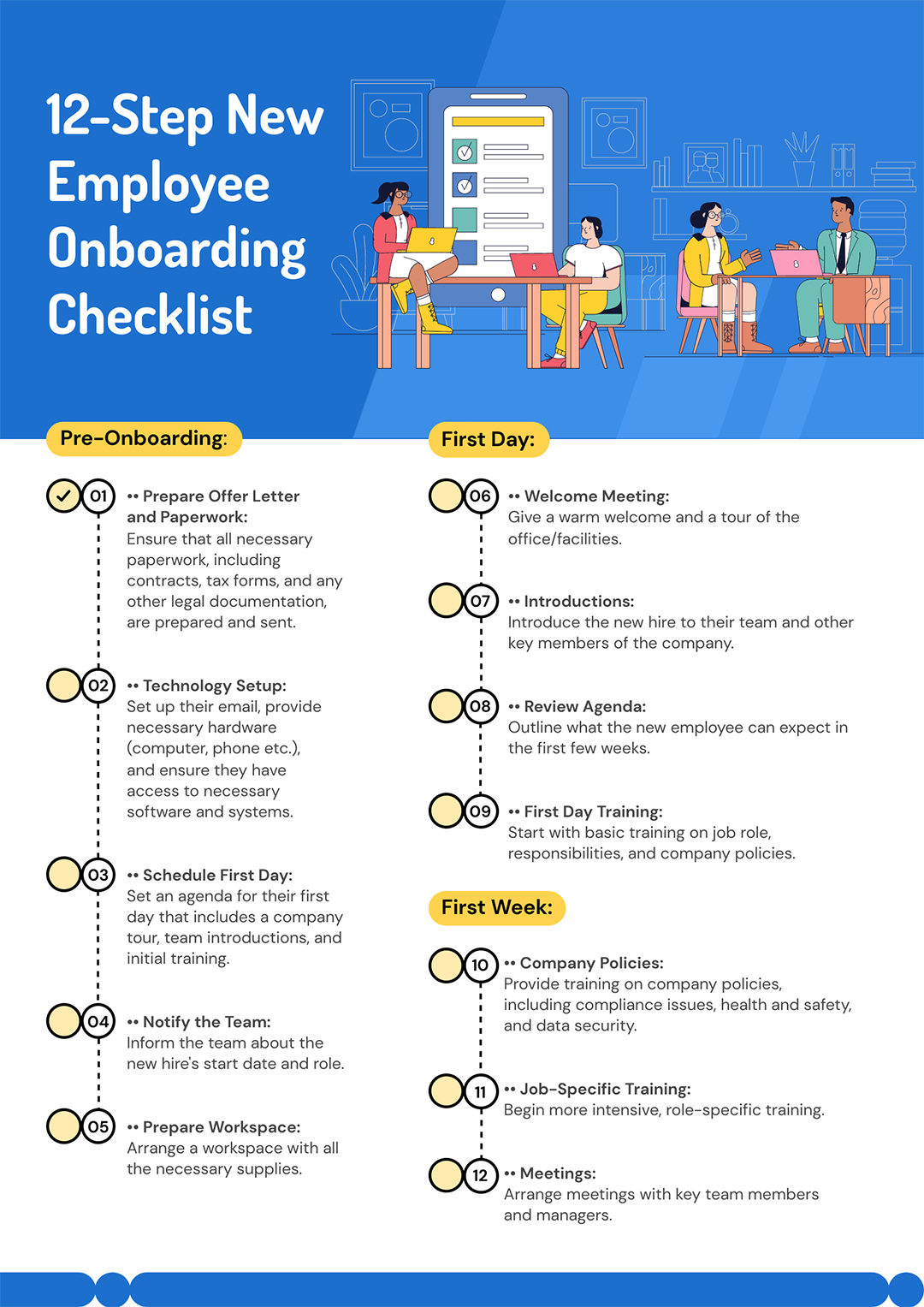
Click here to download our 12-step new employee onboarding checklist.
While I recommend creating a well structured onboarding process and to turn that into a system, I do not recommend using the same system on all of your new hires. That brings us to the next section.
Onboarding Magic: Tailoring Programs for Every Seniority Level 🎩
Newbies on Board: Entry-Level Employees 🌱
For entry-level employees, let’s focus on getting them comfortable in the professional world. Teach them about the company’s values, expectations, and their job duties.
- Job-Specific Training: Offer in-depth training for their day-to-day tasks.
- Company Culture: Help them embrace the company’s mission and environment.
- Meet the Team: Introduce them to their teammates and roles.
- Mentorship Matters: Pair them with a mentor for guidance and support.
Leveling Up: Mid-Level Employees ⬆️
Mid-level employees have industry experience but need help navigating their new roles within your organization.
- Role-Specific Training: Focus on their particular responsibilities.
- Cross-Functional Understanding: Explain how they’ll cooperate with other departments.
- Development Opportunities: Discuss skill-building and career growth chances.
- Performance Expectations: Define what success looks like for them.
Leadership Ready: Senior-Level Employees 💼
Senior-level employees, including executives, bring extensive industry experience. Guide their onboarding towards strategic goals and leadership tasks.
- Strategic Alignment: Ensure they grasp the company’s strategic objectives and their role in achieving them.
- Leadership Expectations: Clarify how they’ll guide teams or departments.
- Networking: Connect them with key leaders within the organization.
- Understanding Company Culture: Encourage them to contribute positively to the existing culture while embracing their leadership style.
One Size Doesn’t Fit All: Personalize Onboarding for Employee Satisfaction 🎁
Remember, each new hire is unique! While seniority levels can guide your onboarding process, consider their individual needs and experiences too. By doing so, you’ll create a personalized and effective onboarding experience for everyone.
Visuals for employee onboarding
Here are some Piktochart visuals that can help you create a most effective employee onboarding automation process, by streamlining communication with the company.
1. New hire first week agenda
This is usually to set up some expectations upfront about what the new employee should expect in the coming week!


2. New hire presentation (to the company)
If it’s your company’s practice to introduce the new hire via presentation, here’s a handy template that will help you.
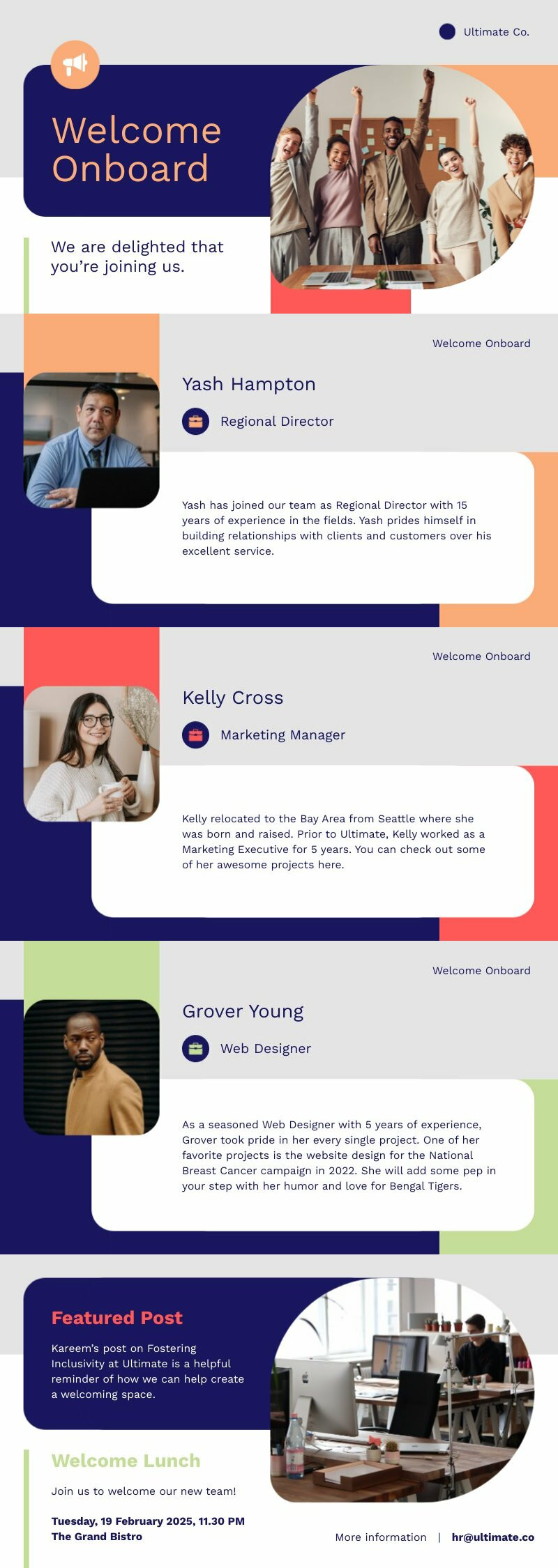
3. Welcome new employee banner (sent on intranet)



4. New hire newsletter (to the company)
If it’s your company’s practice to introduce the new hire via email, here’s a handy template that will help you.
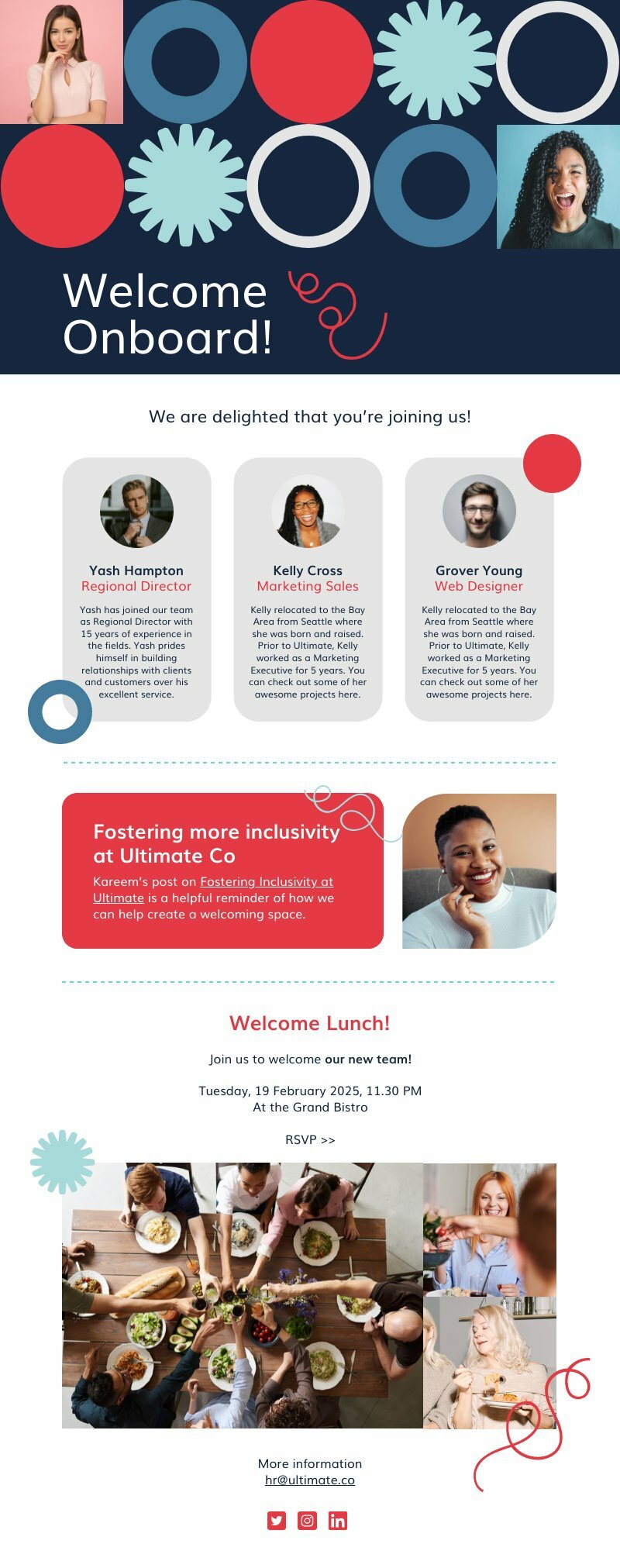
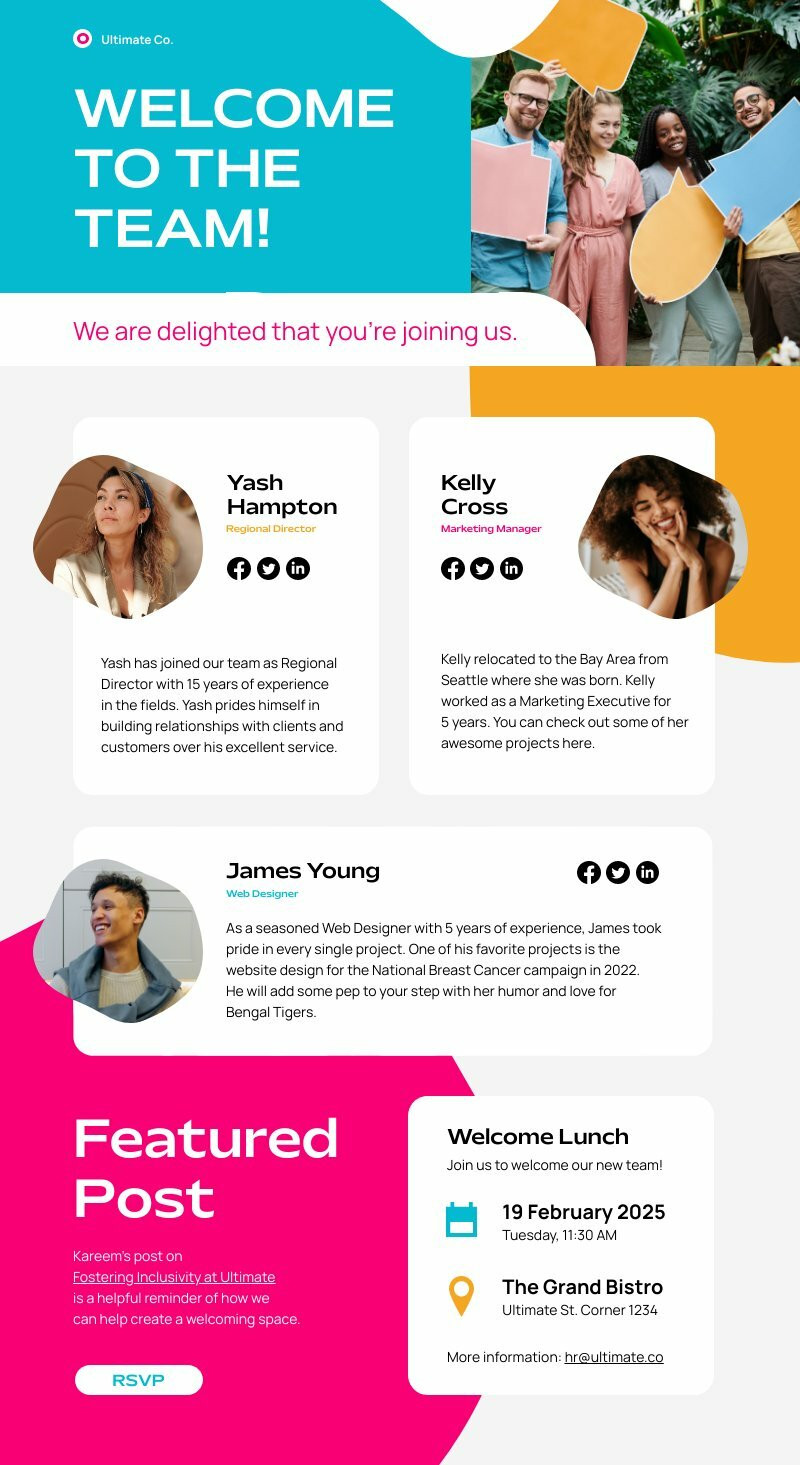
5. Employee onboarding email (to the new hire)
In this document, you do not want to overwhelm, but yet putting in a list of documents they need to sign or read may be a good idea. Ensure that you keep a positive, upbeat tone!
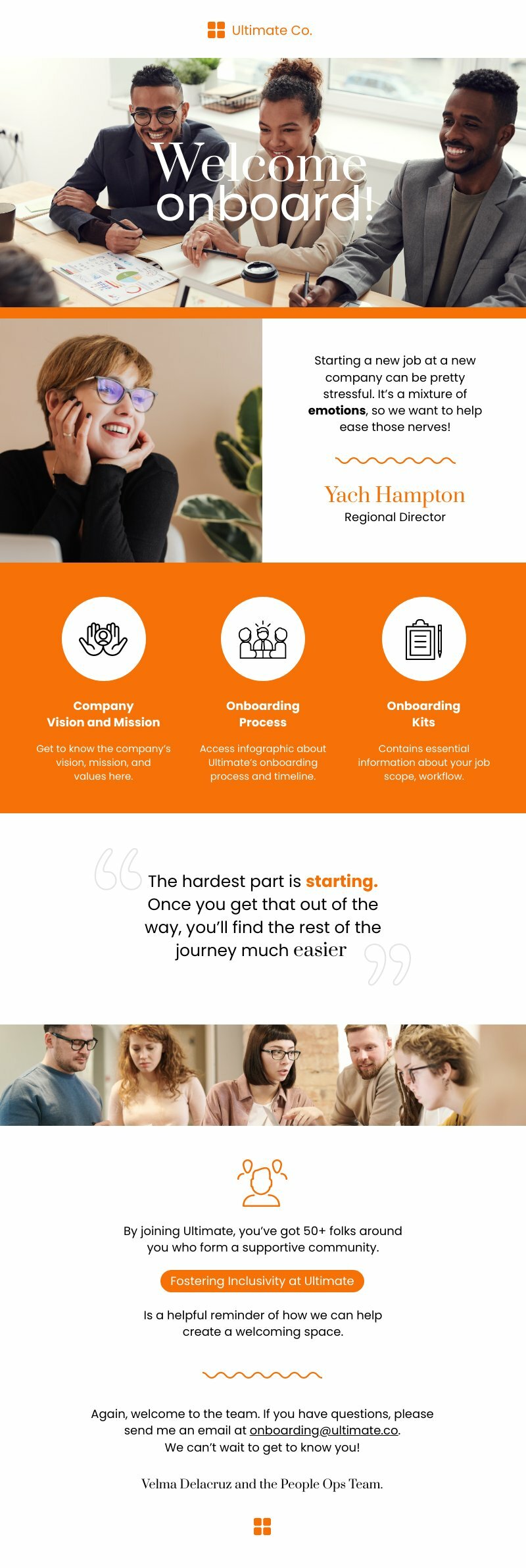
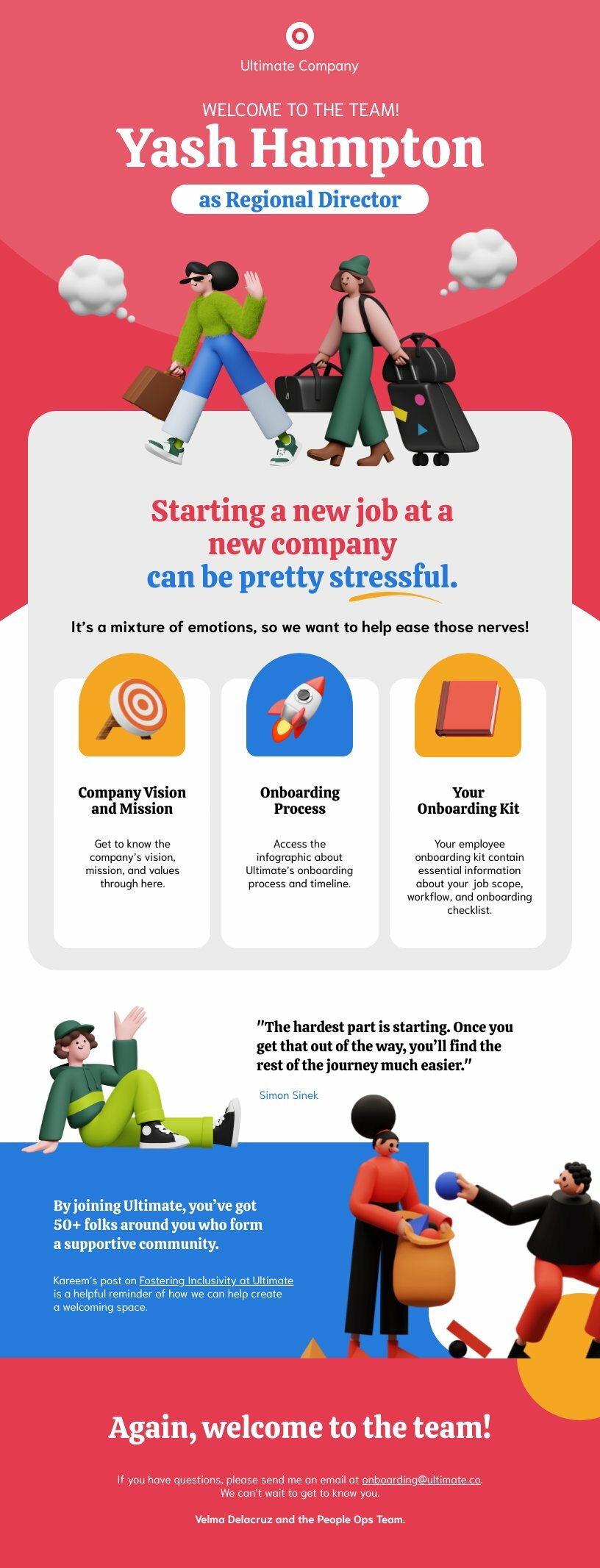
Want access to more templates? Create a free account and customize the template of your choice.
6. New hire introduction (new hire’s own presentation)
Not many companies do this, but at a small company like Piktochart, we love seeing the new hires present themselves, their backgrounds, likes and dislikes, it helps to set the working relationship and also get the person off to a start. Put a face to the name so to speak!

7. Employee onboarding checklist
Having an onboarding checklist helps to ensure a memorable onboarding experience for the new hires!


8. Culture book
One of the more crucial documents during an employee onboarding, we reckon.

9. SOP
Turn your employee SOPs into an interesting infographic. Create it once and reuse it, many times!
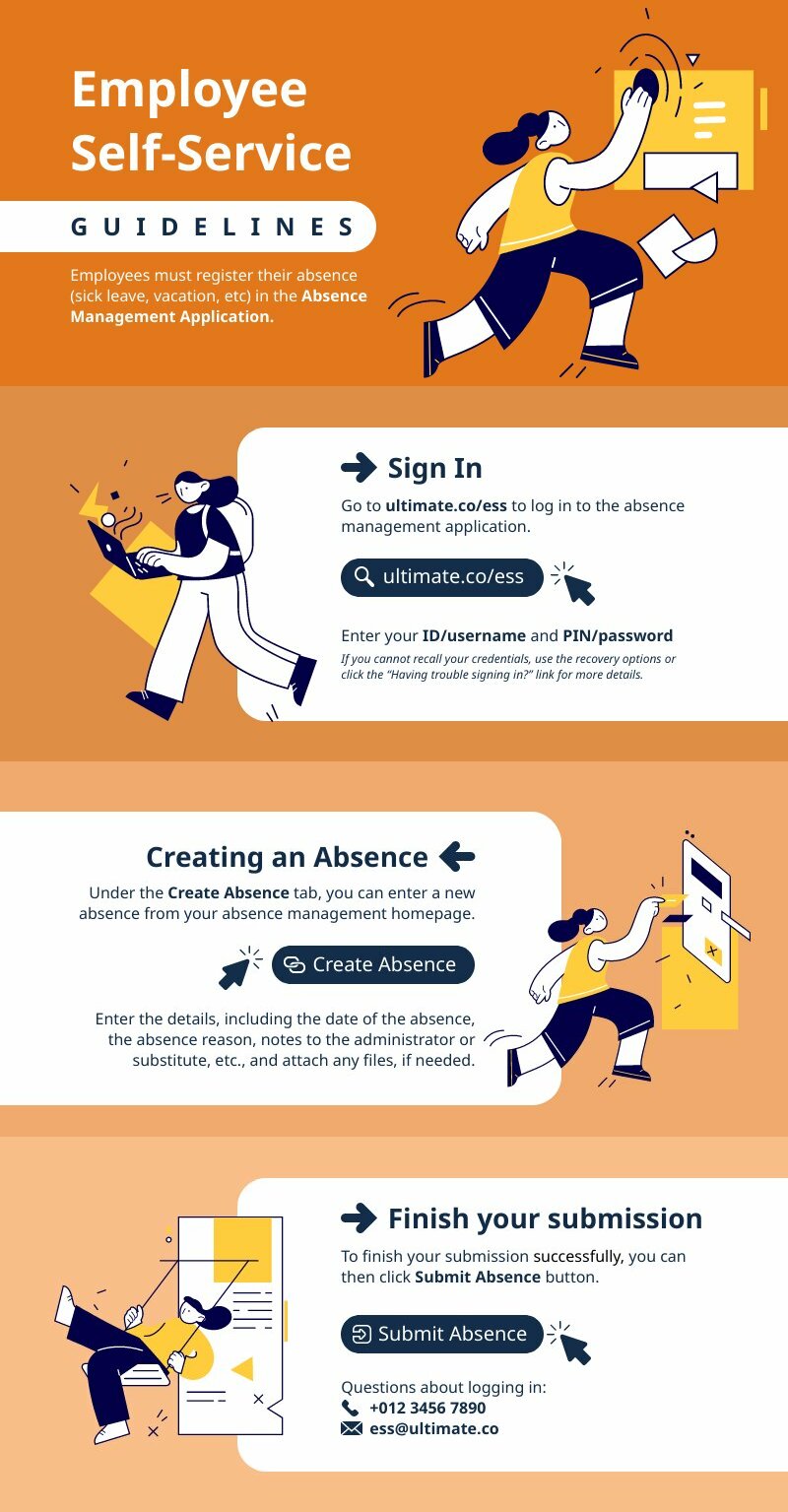
10. Training presentation
A new employee’s onboarding is filled with training, so you would want to space them out and ensure that the training schedule reflects enough time for exploration and rest. The training presentations if used in a concise branding manner, also helps the employee to know what is expected of them.

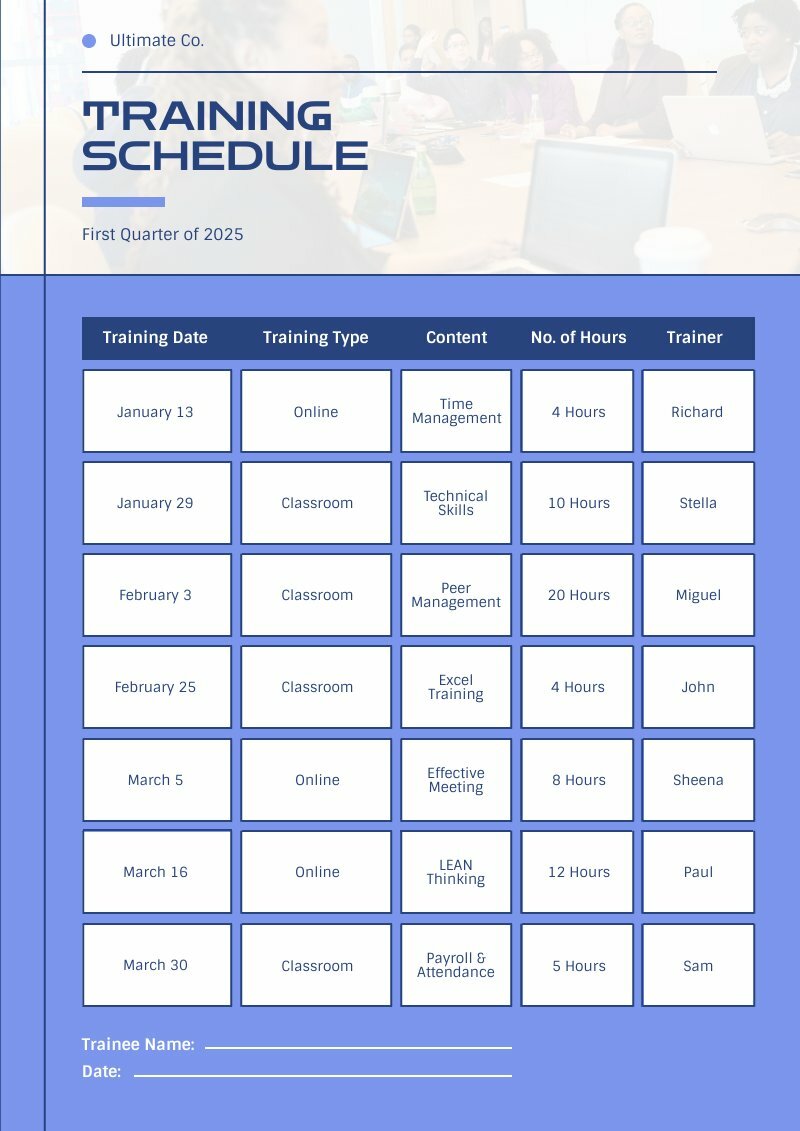
FAQs
1. What should the new employee orientation consist of?
An employee orientation program, also known as an onboarding program, should effectively integrate new employees into the company culture, prepare them for their new roles, and help them understand the expectations of their job. Here are the key components that an orientation program should consist of:
Company Overview: The orientation should start with a comprehensive introduction to the organization. This includes the company’s history, mission, vision, values, culture, and structure. The new employee should understand the company’s goals and how their role contributes to those goals.
Job Specifics: Detailed information about the job role is crucial. This includes: on the job training tasks and responsibilities, performance expectations, job description, any necessary training for the role, and details about the department they will be working in.
Company Policies and Procedures: An overview of the company’s policies, procedures, rules, and regulations should be included. This can cover areas like workplace safety, harassment policies, leave policies, communication procedures, etc.
Introduction to the Team: A tour of the workplace and introduction to other team members and key personnel in the organization can help new employees feel more comfortable and connected. It’s important for them to know who they’ll be working with directly and who they can approach for help or guidance.
Resources and Tools: New employees should be introduced to the systems, software, equipment, and tools they will be using as part of their job. This can include everything from their workstation setup, to email and communication tools, to specific software used for their role.
Employee Benefits and Perks: Information on compensation, benefits, perks, and the employee assistance program should be shared during the orientation. It’s also important to discuss the performance review process and opportunities for professional development.
Training Sessions: Depending on the job role, there may be some initial training sessions that new employees need to participate in. These can cover a wide range of topics, including technical skills, soft skills, company-specific training, etc.
Mentor or Buddy System: Assigning a mentor or buddy can be extremely beneficial for new hires. This person can serve as a go-to resource for any questions or issues that come up, making the new employee’s transition into their role smoother.
Open Forum for Questions and Clarification: Provide an opportunity for new hires to ask questions and get clarifications. This could be a Q&A session at the end of the orientation or an open-door policy that allows new employees to seek answers to their questions whenever they arise.
Follow-up and Feedback: The orientation process shouldn’t end after the first day or week. Regular check-ins during the first few months can help ensure that the employee is settling in well and offer an opportunity to address any issues or concerns that may have arisen.
Keep in mind that an effective employee orientation program is flexible and can be adapted based on feedback, changing needs, or specific job roles.
2. What’s the best practice for a mentoring program?
Creating a mentoring program for new employees is a great way to boost employee engagement, their professional development, performance and retention rates! Here are some tips for designing and implementing an effective mentoring program:
1. Clear Objectives: The first step is to define the objectives of the mentoring program. This could include things like increasing retention, boosting performance, or fostering a better understanding of the company culture. Having clear goals will guide the structure of the program and make it easier to measure its effectiveness.
2. Program Structure: Decide on the structure of the program. Will it be a one-on-one mentoring relationship, or will it involve groups or teams? Will it be a formal or informal program? How long will the mentoring relationship last? Having a clear structure will ensure that everyone understands what’s expected of them.
3. Mentor Selection: Not everyone is cut out to be a mentor. The mentors should be experienced employees who have a solid understanding of the company culture and the skills to guide and support a new hire. They should be good listeners, empathetic, trustworthy, and have a genuine interest in helping other employees and others succeed.
4. Matching Mentors and Mentees: The process of pairing mentors and mentees is crucial. Factors to consider can include similar interests, career goals, personalities, or the specific skills and knowledge the mentee wants to develop. Some organizations let mentees choose their mentors to ensure a good fit.
5. Training: Both mentors and mentees should receive training before the mentoring relationship begins. For mentors, this could cover topics like coaching skills, communication techniques, and how to give constructive feedback. Mentees might be trained on how to set goals, give feedback, and make the most out of the mentoring relationship.
6. Establish Expectations: Both the mentor and mentee should understand their roles, responsibilities, and the expectations of the mentoring relationship. This could include how often they’ll meet, what topics they’ll discuss, and what goals they want to achieve.
7. Provide Support: Both mentors and mentees should have access to ongoing support. This could be from a dedicated program manager or a full HR team representative who can provide guidance, resolve any issues, and help keep the mentoring relationship on track.
8. Feedback and Evaluation: Regular feedback and evaluation are key to improving the mentoring program over time. Consider creating a formal process where mentors and mentees can share their experiences, provide feedback, and suggest improvements.
9. Confidentiality: Mentors and mentees must trust each other to ensure the success of their relationship. Therefore, it is important to establish a code of confidentiality at the beginning of the program.
10. Recognize and Reward: Recognize the time and effort mentors put into the program. This recognition can be formal or informal, but it should demonstrate the company’s appreciation of the mentor’s contribution.
By following these best practices, you can create a mentoring program that benefits not only the new employees and their mentors, but the whole organization’s culture as a whole.
3. How do you clarify roles and responsibilities for a new employee?
At Piktochart, we make sure that our onboarding process covers all bases, including a thorough review of the job description and performance expectations. We provide a comprehensive document on performance evaluations, but our team leaders go the extra mile.
They personally guide new team members through OKRs, ensuring that everyone knows what’s expected of them to succeed. To top it off, our CEO even takes the time to chat with each individual at the end of their first month, celebrating their accomplishments and offering any necessary guidance.
Though this practice might not be as feasible in larger organizations, the foundation remains the same. Employees must have a clear understanding of their job description, reporting lines, and performance expectations from day one. And of course, fostering open communication is key – making sure that our team members feel comfortable asking for clarification whenever it’s needed.
Piktochart offers professionally-designed templates to create reports, presentations, brochures, and more. Sign up for a free account today to create impressive visuals with minimal time and effort to personalize the template.
